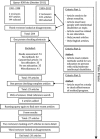Identifying effective methods for teaching sex education to individuals with intellectual disabilities: a systematic review
- PMID: 25085114
- PMCID: PMC4409057
- DOI: 10.1080/00224499.2014.919373
Identifying effective methods for teaching sex education to individuals with intellectual disabilities: a systematic review
Abstract
Sex education for individuals with intellectual disabilities is important. However, our knowledge about effective methods for teaching sex education to this population is limited. We report the results of a systematic review identifying methods for sex education programs aimed at individuals with intellectual disabilities. In all, 20 articles were included that met the criteria set in terms of topic--the effectiveness of sex education programs--and population of interest--individuals with intellectual disabilities. In these articles, methods for increasing knowledge and for improving skills and attitudes were reported. However, the studies revealed that generalization of skills to real-life situations was often not achieved. There are indications that the maintenance of knowledge and skills still needs extra attention. Moreover, detailed descriptions of the program materials, program goals, and methods used in the programs were often lacking in the reports. Although there is some evidence for methods that may improve knowledge, attitudes, and skills with regard to sex education aimed at individuals with intellectual disabilities, due to the lack of detailed descriptions provided it is unclear under which conditions these methods work. We therefore suggest that authors provide additional detail about methods in future publications or in online supplements.
Similar articles
-
Parent training interventions for parents with intellectual disability.Cochrane Database Syst Rev. 2018 Jul 13;7(7):CD007987. doi: 10.1002/14651858.CD007987.pub3. Cochrane Database Syst Rev. 2018. PMID: 30004571 Free PMC article.
-
Behavioral interventions to reduce risk for sexual transmission of HIV among men who have sex with men.Cochrane Database Syst Rev. 2008 Jul 16;(3):CD001230. doi: 10.1002/14651858.CD001230.pub2. Cochrane Database Syst Rev. 2008. PMID: 18646068
-
Systemic pharmacological treatments for chronic plaque psoriasis: a network meta-analysis.Cochrane Database Syst Rev. 2021 Apr 19;4(4):CD011535. doi: 10.1002/14651858.CD011535.pub4. Cochrane Database Syst Rev. 2021. Update in: Cochrane Database Syst Rev. 2022 May 23;5:CD011535. doi: 10.1002/14651858.CD011535.pub5. PMID: 33871055 Free PMC article. Updated.
-
Community Member Views on Autism Intervention: Effects of Closeness to Autistic People with Intellectual Disabilities And Nonspeaking Autistic People.Autism Adulthood. 2024 Sep 16;6(3):253-271. doi: 10.1089/aut.2023.0202. eCollection 2024 Sep. Autism Adulthood. 2024. PMID: 39371356
-
Interventions for preventing abuse in the elderly.Cochrane Database Syst Rev. 2016 Aug 16;2016(8):CD010321. doi: 10.1002/14651858.CD010321.pub2. Cochrane Database Syst Rev. 2016. PMID: 27528431 Free PMC article.
Cited by
-
Contraceptive use at first sexual intercourse among adolescent and young adult women with disabilities: The role of formal sex education.Contraception. 2021 Mar;103(3):178-184. doi: 10.1016/j.contraception.2020.12.007. Epub 2020 Dec 23. Contraception. 2021. PMID: 33359508 Free PMC article.
-
Identifying behavioural determinants for interventions to increase handwashing practices among primary school children in rural Burundi and urban Zimbabwe.BMC Res Notes. 2017 Jul 14;10(1):280. doi: 10.1186/s13104-017-2599-4. BMC Res Notes. 2017. PMID: 28705260 Free PMC article.
-
A systematic review of relationships and sex education outcomes for students with intellectual disability reported in the international literature.J Intellect Disabil Res. 2022 Jul;66(7):577-616. doi: 10.1111/jir.12952. Epub 2022 Jun 13. J Intellect Disabil Res. 2022. PMID: 35698311 Free PMC article.
-
Evidences of an Implemented Training Program in Consensual and Responsible Sexual Relations for People with Intellectual Disabilities.Int J Environ Res Public Health. 2021 Feb 26;18(5):2323. doi: 10.3390/ijerph18052323. Int J Environ Res Public Health. 2021. PMID: 33652989 Free PMC article.
-
Persons with Intellectual Disability: Sexual Behaviour, Knowledge and Assertiveness.Zdr Varst. 2021 Mar 18;60(2):82-89. doi: 10.2478/sjph-2021-0013. eCollection 2021 Jun. Zdr Varst. 2021. PMID: 33822835 Free PMC article.
References
-
- Abbott D., Burns J. What's love got to do with it? Experiences of lesbian, gay, and bisexual people with intellectual disabilities in the United Kingdom and views of the staff who support them. Sexuality Research and Social Policy: A Journal of the NSRC. 2007;4:27–39. doi: 10.1525/srsp.2007.4.1.27. - DOI
-
- Abbott D., Howarth J. Still off-limits? Staff views on supporting gay, lesbian, and bisexual people with intellectual disabilities to develop sexual and intimate relationships. Journal of Applied Research in Intellectual Disabilities. 2007;20:116–126. doi: 10.1111/j.1468-3148.2006.00312.x. - DOI
-
- Albarracín D., Gillette J. C., Earl A. N., Glasman L. R., Durantini M. R., Ho M. H. A test of major assumptions about behavior change: A comprehensive look at the effects of passive and active HIV-prevention interventions since the beginning of the epidemic. Psychological Bulletin. 2005;131:856–897. doi: 10.1037/0033-2909.131.6.856. - DOI - PMC - PubMed
-
- Diagnostic and statistical manual of mental disorders. (4th ed., text rev.) Washington, DC: Author; 2000. American Psychiatric Association.
Publication types
MeSH terms
LinkOut - more resources
Full Text Sources
Other Literature Sources
Medical
Miscellaneous

